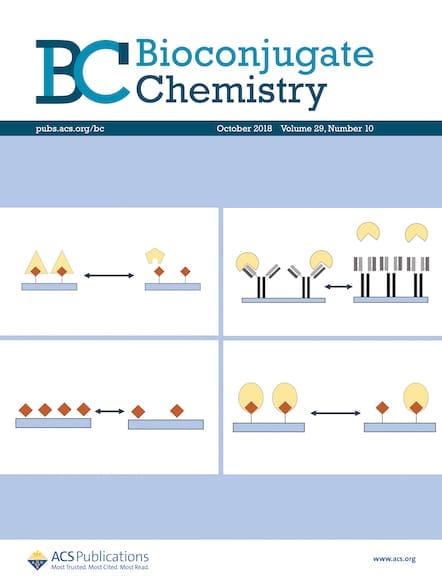Read an exclusive interview with Dr. Xiao covering his history with the journal, his research collaborators, and his advice for starting a new lab.

Bioconjugate Chemistry and the ACS Division of Polymeric Materials: Science and Engineering present the 2025 Bioconjugate Chemistry Young Investigator Award, which recognizes an outstanding young researcher who has made a major impact at the interface of synthetic and biological systems.
This year’s recipient is Dr. Han Xiao, the Founder and Director of the SynthX Center and an Associate Professor in the Department of Chemistry, Biosciences, and Bioengineering at Rice University.
The award will be presented at ACS Fall 2025 in Washington, DC, from August 17-21. Dr. Xiao will present a lecture as part of the Bioconjugate Chemistry Lectureship Symposium at the meeting, along with other prominent researchers in the field. Further details to come.

Dr. Xiao earned his B.S. in Chemistry and an Honors Degree in Physical Science from the University of Science and Technology of China (USTC) in 2010. He then pursued his Ph.D. at The Scripps Research Institute (TSRI) under Prof. Peter G. Schultz, where he expanded the genetic incorporation of unnatural amino acids (ncAAs) in both prokaryotic and eukaryotic systems to advance cancer therapeutics. In 2015, Han joined Prof. Carolyn R. Bertozzi’s lab at Stanford University as a Good Ventures Postdoctoral Fellow of the Life Sciences Research Foundation. His postdoctoral research focused on developing novel cancer immunotherapies targeting cell-surface glycan-mediated immune modulation. Han began his independent research at Rice University in July 2017, where his lab focuses on developing innovative chemical biology tools to probe complex biological systems and pioneer new therapeutic strategies.
His contributions have been recognized with prestigious awards, including the Breast Cancer Research Program Breakthrough Award (DoD, Level 2), Maximizing Investigators’ Research Award (NIH), Norman Hackerman-Welch Young Investigator Award, and CPRIT Faculty Recruitment Award.
Read the Interview with Dr. Xiao
What does this award mean to you?
I am truly honored to receive the 2025 Bioconjugate Chemistry Young Investigator Award. Since my Ph.D., I have been proud to publish in this journal and contribute to it in various capacities over the years. Receiving this recognition from Bioconjugate Chemistry is especially meaningful, as it reflects the collective efforts of my lab. This achievement would not have been possible without the brilliance, creativity, and dedication of the outstanding students and postdocs who have worked alongside me. I look forward to continuing our contributions to the field, as Bioconjugate Chemistry remains a driving force for groundbreaking biological discoveries and therapeutic innovations.
What is your history with Bioconjugate Chemistry?
As a junior faculty member, one of the biggest challenges was publishing the first paper in a new field. We are incredibly proud that our first paper, introducing the proximity-induced antibody labeling technology, was published in Bioconjugate Chemistry. The insights from the editors and reviewers played a crucial role in shaping this innovative and powerful approach. This technology enabled the development of the first bone-targeting antibodies, ultimately leading to the founding of OsteoLogic Therapeutics in 2022. The company is now pioneering the development of bone-targeting drugs with support from Pillar VC, NY Ventures, and Curie Bio Venture Capital. The support of Bioconjugate Chemistry for young investigators and the broader scientific community is invaluable, driving numerous breakthroughs in both technology and clinical medicine.
How did your team come together to collaborate on this research?
Real-world problems naturally bring together experts from different disciplines, fostering collaboration to develop effective solutions. Our approach has always been to first identify a critical problem and then integrate the necessary technologies and strategies to address it. In today’s scientific landscape, no single lab can resolve complex issues in isolation. Meaningful progress requires leveraging the expertise of specialists across fields, fostering an environment of shared knowledge and innovation. We actively collaborate with experts to gain a deep understanding of the problem, employ a multidisciplinary approach to develop innovative solutions, and engage in entrepreneurial efforts to accelerate the translation of our research into impactful real-world applications. This collective effort not only drives scientific advancement but also ensures that our work can make a tangible difference in medicine and technology.
What is next in your research?
AI is becoming increasingly important in both fundamental and translational research. A key challenge is how to integrate AI into current research to accelerate discoveries that were previously unattainable. Applying AI effectively across different scientific fields still requires large, clean, and accurate datasets. One of our research directions aims to leverage our existing technologies to generate high-quality data that can fuel AI-driven studies, ultimately enabling breakthroughs that traditional experimental approaches alone cannot achieve.
What would your advice be to someone just starting out in the field?
Starting a new lab begins with identifying a practical and impactful problem that holds significance for both scientific progress and real-world applications. Interdisciplinary collaboration not only helps in defining such challenges but also drives innovative solutions. However, even with a well-defined research focus and strong partnerships, achieving meaningful progress requires determination and persistence. Challenges and setbacks are inevitable, but maintaining a clear vision and unwavering commitment to long-term goals is essential for success.
